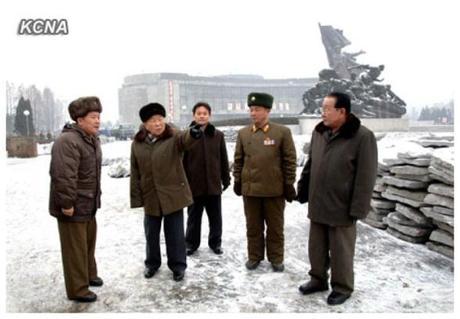
Choe Yong Rim (2nd L) tours renovation construction work at the Victorious Fatherland Liberation War (Korean War ) Museum in Pyongyang (Photo: KCNA)
DPRK state media reported on 24 January (Thursday) that DPRK Cabinet Premier Choe Yong Rim visited a steel production unit at Ch’o'llima Steel Complex and toured the renovation work at Victorious Fatherland Liberation War (Korean War) Museum. Choe first visit was a tour of Steel Shop #1 at Posan Steel Works, a unit of the Ch’o'llima Steel Complex located between Pyongyang and Namp’o. According to KCNA during a meeting with the factory officials “it was underscored. . .to ensure materials needed for repairing furnaces of the Works in order to increase the steel production, and to transport raw materials.” Choe later toured construction work renovating the Victorious Fatherland Liberation War Museum in central Pyongyang. The renovation was initiated by Kim Jong Un during the summer of 2012 and is scheduled to be completed for the 60th anniversary of the end of the Korean War’s active hostilities which falls in July 2013. Choe “ learned in detail about building operation in various construction sites including open-air exhibition” and “encouraged the soldier-builders who were making innovations in the construction of interior after finishing the frame of the museum true to the noble intention of the dear respected Supreme Commander Kim Jong Un.” Choe convened a meeting with management and Korean People’s Army [KPA] personnel involved in the renovation. According to KCNA “at the meeting organization work of relevant units to satisfactorily produced and supply building materials was made.”
Choe’s visit to the museum construction, after the country’s supreme power organization the DPRK National Defense Commission issued a statement that the country has initiated an “upcoming all-out action” involving a ”a variety of satellites and long-range rockets which will be launched by the DPRK one after another and a nuclear test of higher level” is no accident. It is buttressed by recent state media rhetoric found in a 17 January 2013 Rodong Sinmun editorial:
Some countries, due to their weak national defense capabilities even though they enjoy an affluent material life, become scared when imperialists come up with unjust demands and conditions and raise their voices. This shows that if countries do not reinforce their gun barrel, they will be politically and militarily overwhelmed by imperialists and fall into a slavish position, no matter how affluent and rich their material living conditions may be. Historical experience shows that countries with weak military power will not be able to even defend their political independence, let alone building their economy.
Choe’s visit serves as a gentle reminder to all countries in the northeast Asia neighborhood that the Fatherland Liberation War (Korean War) concluded with an armistice, and has yet to see its formal conclusion. Choe Yong Rim, a veteran of the Korean War, has served on policy working groups linked to crisis management (the phrase “all-out action” implies that the DPRK has been put into national crisis mode, or what some would describe as a war-time posture) and preparations for experimental nuclear detonations (in 2006, and 2009). That he toured the war museum, in a brutally chilly climate for an octogenarian, reiterates one reason the DPRK, at significant expense to its entire population, earmarks precious national resources to the development of long-range missiles and nuclear weapons. The last reported leadership visit to the war museum was in late December 2012 when Director of the KPA General Political Department, Gen. Choe Ryong Hae toured the construction site. Choe Yong Rim last visited the museum renovation in late October 2012. Interestingly, Choe’s last reported to the museum renovation was also paired with a tour of iron and steel complexes, including the Ch’o'llima Steel Complex, which carries with it the symbolism of post-Korean War construction.
Filed under: 2013 Strategic Rhetoric, 27 July 2012 (Victory Day/Armistice), 2nd Academy of Natural Science, capital construction, Central Committee, Central Military Committee, central party life, Choe Ryong Hae, Choe Yong Rim, critical infrastructure, Culture Section (bureau), DPRK Cabinet, DPRK External Relations, DPRK Premier, dprk-unc, Fatherland Liberation War (Korean War), Guard Command, Kim Chong-un inspections, Kim Family, Kim Jong Un Visits, Kim Jong-un, KJI Personal Secretariat, Korean People's Army (KPA), Korean Workers' Party (KWP), KPA construction battalions, KPA construction brigades, KPA General Political Bureau, KPA General Political Department, KPA supernumerary organizations, Machine Building Industry Department, Ministry of Metal Industry, Ministry of the People's Armed Forces (MPAF), MPAF GPB, National Defense Commission (NDC), NDC Administration Department, North Korean press, nuclear weapons, Organization and Guidance Department, Party elders, Party History Institute, party life, Political Bureau, Propaganda and Agitation Department, Pyongyang Defense Command, Second Economic Committee, Second Economy Commission, Secretariat, Six Party Talks, State Planning Commission (SPC)
